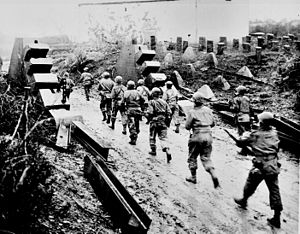Rhineland Campaign
| Siegfried Line Campaign | |||||||
|---|---|---|---|---|---|---|---|
| Part of World War II | |||||||
 U.S. Army troops cross the Siegfried Line. |
|||||||
|
|||||||
| Belligerents | |||||||
|
Western Allies and others |
|
||||||
| Commanders and leaders | |||||||
|
(SHAEF) (21st Army Group) (12th Army Group) (6th Army Group) |
(Oberbefehlshaber West) (Army Group B) |
||||||
| Strength | |||||||
| 4.5 million troops (91 divisions) | ~1,500,000 troops | ||||||
| Casualties and losses | |||||||
|
U.S.: |
|
||||||
U.S.:
240,082 casualties
(50,410 killed,
172,450 wounded,
24,374 captured or missing)
(15 September 1944 – 21 March 1945)
U.K.
~32,366
Total:
272,448+
400,000+ casualties
The Allied advance from Paris to the Rhine was a phase in the Western European Campaign of World War II.
This phase spans from the end of the Battle of Normandy, or Operation Overlord, (25 August 1944) incorporating the German winter counter-offensive through the Ardennes (commonly known as the Battle of the Bulge) and Operation Nordwind (in Alsace and Lorraine) up to the Allies preparing to cross the Rhine in the early months of 1945. This roughly corresponds with the official United States military European Theater of Operations Rhineland and Ardennes-Alsace Campaigns.
German forces had been routed during the Allied break-out from Normandy. The Allies advanced rapidly against an enemy that put up little resistance. But after the liberation of Paris in late August 1944, the Allies paused to re-group and organise before continuing their advance from Paris to the Rhine. The pause allowed the Germans to solidify their lines — something they had been unable to do west of Paris.
By the middle of September 1944, the three Western Allied Army groups; the British 21st Army Group (Field Marshal Sir Bernard Montgomery) in the north, the United States US 12th Army Group (General Omar Bradley) in the center, and the Franco-American Sixth United States Army Group (Lieutenant General Jacob L. Devers) in the south, formed a broad front under the Supreme Allied Commander General Dwight D. Eisenhower and his headquarters SHAEF (Supreme Headquarters, Allied Expeditionary Force).
...
Wikipedia
